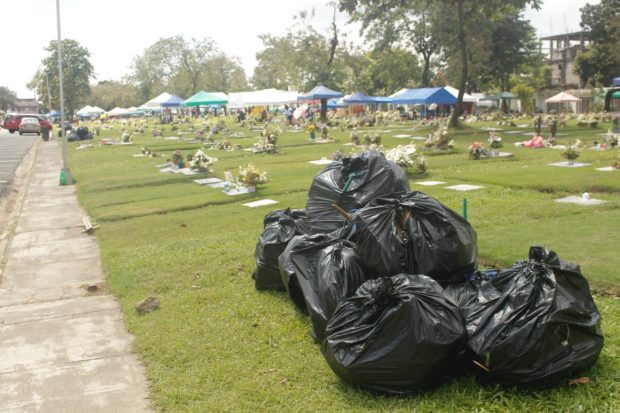
INQUIRER.net photo / Gabriel Pabico Lalu
Recovering tons of garbage after occasions in the Philippines — be it parties, concerts, or other festivities — is fairly common. For this year’s All Souls’ Day, people who visited cemeteries have left behind trash, and while many are alarmed, most are not even surprised.
Garbage and All Souls’ Day always go hand-in-hand. Waste management has always been a nightmare for local government units (LGUs) and agencies, especially those in charge of the Manila North and Manila South Cemeteries.
But not in Marikina — inside the Loyola Memorial Park, the trash does not get mixed up with candles, flowers, and grasses.
Instead, they are properly contained in garbage bags and placed in areas where garbage collectors and street sweepers deputized by the local government can collect it with ease.
INQUIRER.net photo / Gabriel Pabico Lalu
According to the cleaners, they were given the opportunity to maintain orderliness in cemeteries for 10 days, in exchange for allowances — not a bad investment by the government if the returns are neat streets and a clean environment.
“Volunteer po kami ni mayor, 10 days lang po kaming maglilinis dito, may allowance lang,” a female volunteer told INQUIRER.net on Friday.
“Tulong kasi ito dahil Undas din naman, pansamantalang trabaho na rin po, program ng DOLE (Department of Labor and Employment) na nilapit din ni mayor para makatulong sa mga tao,” she added.
(We’re volunteers of the mayor, we will clean cemeteries for 10 days for some allowance. It is a way of helping since it is All Souls’ Day, they gave us temporary jobs through the labor department’s program which was introduced to us by the mayor.)
Joint efforts
According to another cleaner, hundreds of other cleaners were also deployed in other cemeteries within the city.
INQUIRER.net photo / Gabriel Pabico Lalu
“Meron din sa ibang lugar, sa Barangka, dito sa Aglipayan (Cemetery), sa OLA (Our Lady of the Abandoned Church) meron din, para mapanatiling malinis ‘yong mga sementeryo,” he said.
(There are other cleaners in different areas, in Barangka, in the Aglipayan Cemetery, there are others in OLA, to maintain the cleanliness of cemeteries.)
However, the cleaners also admitted that aside from the government, the civilians and establishments also deserve praise for doing their share. One of them even said that they believe the areas would still be clean even without their presence.
“Disiplinado naman dito, meron ding talagang naglilinis. May kanya-kanya naman po silang basurahan, kinukuha lang po namin ‘pag puno na ‘yong basura,” the male cleaner said.
(They are disciplined here, they clean their areas. They have their own garbage bags, then we get it when it is full.)
After throwing their wastes inside the garbage bags, visitors of cemeteries were seen placing it properly along sidewalks for authorities to easily pick them up. What is amazing for them is that some of the people have actually segregated the waste before placing it in bags.
“Minsan bago pa namin kuhanin bukod na, minsan sama-sama rin. Sila (visitors), sine-segregate nila, pero pati mga naghahakot, meron din pong tiga-segregate. Kanina, hiniwalay nila ‘yong mga plastic bottle sa nabubulok,” the female cleaner explained.
(Sometimes, before we get the trash, it is already organized, but sometimes it is not. Some of the visitors do segregation, but even if they don’t, garbage collectors would do it. A while ago we saw plastic bottles segregated from biodegradable items.)
Learning from the past
Not everything in Marikina is good, especially a few years ago. While it is well-known for producing high quality shoes at a low price and the various food parks and stalls, it is an area to avoid during the rainy season.
In fact, when storms are expected to affect Metro Manila, news outlets are already monitoring the situation in the city.
It might be safe to say that people of Marikina City have learned their lessons the hard way. In 2009, more than 70 residents died after Typhoon “Ondoy” brought rains worth a month in just a span of three days.
The cleaners also attested to the change in people’s ways, specifically in terms of littering and the ban on use of plastics.
“Disiplinado naman ang mga tao dito sa Marikina noon pa. Pero mas ngayon, marami na po kasi nasita ang munisipyo, ayaw nila ng ganyang may pakalat-kalat, kahit sa kalsada may tiga-walis,” they said.
(People from Marikina are disciplined even before. But more so today, because many have been caught by the government, they do not want to litter, even there are sweepers in the streets.)
“Pinag-bawal na rin po kasi ‘yong mga plastic. Meron pa rin naman kaming nakikitang plastic pero bihira lang,” they added.
(Using plastic bags is not allowed here. We still see plastics in garbage bags but only seldom.)
For some, the storm was a blessing in disguise. It might have been the reason why Marikina residents have initiated cleaning their own backyards — or tombs — because they do not want a repeat of the incident.
“Grabe ‘yong nangyari sa amin no’ng 2009, no’ng Ondoy,” a male visitor in Loyola Memorial Park, who lives in the nearby Provident Villages, told INQUIRER.net. “Akala namin katapusan na namin ‘yon.”
“Kaya siguro no’ng may opportunity na ayusin, natakot na, inayos nila ‘yong sa basura,” he added.
(The floods in 2009, during the height of Typhoon Ondoy, were so high that we thought that would be the end for us. Maybe when they saw the opportunity to fix things, they were scared after the incident, they fixed the garbage disposal system.) /jpv
RELATED STORY
61 truckloads of trash amassed from Manila cemeteries since October 30